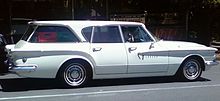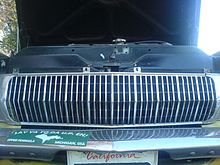- Dodge Lancer
-
Not to be confused with Mitsubishi Lancer or Mitsubishi Lancer Evolution.
Dodge Lancer 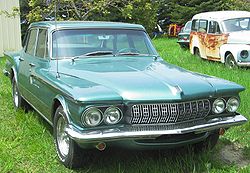
Manufacturer Chrysler Corporation Production 1955–1959
1961–1962
1985–1989Successor Dodge Dart (for 1963)
Dodge Spirit (for 1989)Platform FR layout A-body (for 1961–62)
FF layout H-body (for 1985–89)The Dodge Lancer is a passenger car from the Dodge division of Chrysler Corporation. Dodge used the Lancer name on three different vehicles over the years.
Contents
1955–1959
Dodge used the Lancer name from 1955 to 1959 to designate both two and four door pillarless hardtop models in the Coronet, Royal and Custom Royal lines. The Custom Royal Lancer was a hardtop only and top of the line model for Dodge in 1959. There were 6278 2 door hardtops made and 5019 4 door hardtops made in 1959. Only 11,397 Custom Royal Lancers were made. The Custom Royal Lancer featured a big block engine 361 cubic inches at 305 horsepower. A D-500 option was available which was a 383 cubic inch engine with a single Carter 4 barrel carburetor rated at 320 horsepower and a Super D-500 engine option, a 383 cubic inch engine with dual 4 barrel carburetors rated at 340 horsepower. The Custom Royal Lancer also featured padded dashboard, steering wheel, Lancer emblems on the fenders, steering wheel, hubcaps and glove box, foot operated wind sheild wipers, dual radio antennas, deluxe side trim and thick chrome eyebrows. Optional equipment included power windows, brakes, air conditioning and swivel seats. The Lancer designation was dropped for 1960.
1961–1962
1961–1962 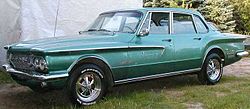
Production 1961–1962 Assembly United States: Detroit, Michigan
Hamtramck, Michigan
Los Angeles, California
Newark, Delaware
St. Louis, Missouri
Mexico: Mexico City
Switzerland: AMAG Automobil- und Motoren, SchinznachClass Compact Body style 2-door hardtop
2-door sedan
4-door sedan
4-door station wagonLayout FR layout Platform A-body Engine 170 cu in/2.8 l Slant-6
225 cu in/3.7 l Slant-6Transmission 3-speed manual
3-speed A904 automaticRelated Plymouth Valiant
Chrysler ValiantFor the 1961 model year, Dodge applied the Lancer nameplate to its higher-priced, upmarket badge-engineered clone of Chrysler's very popular Valiant compact. The model was introduced when Chrysler officially assigned the Valiant to Plymouth division for 1961, leaving Dodge dealers without a compact to sell. All the same body variants available on the Valiant were also available on the Lancer: 2- and 4-door sedans, 2-door coupes, and 4-door wagons.
Styling & trim
The Lancer wheelbase and body shell were identical to those of the Valiant, but interior and exterior trim were fancier on the Lancer. Lancers featured round taillights and a full-width grille, instead of the Valiant's cat's-eye taillights and central grille. For 1961, trim levels were the basic 170 and the premium 770. In 1961, the 2-door hardtop was marketed as the Lancer 770 Sports Coupe, essentially a "performance appearance package". For 1962, the Sports Coupe was given the more concise model name of GT and carried premium trim; 2-tone paint was available and instead of the front bench seat, there were two bucket seats.
Also for the 1962 model, "Lancer GT" medallions were mounted on the doors' interior trim panels below the vent window and on the sides of the front fenders just aft of the headlamps. "GT" emblems were placed on the hood, the deck lid, and on the vinyl dash pad. The headlamp bezels and the grille's horizontal slats were blacked-out. The GT also lacked certain ornamentation found on the 170s and 770s such as the "Lancer" door scripts, the slanted chrome hash marks on the lower quarter panels, and the hook-ended stainless steel door-to-fender spears.
Powertrains
The Lancer used the slant-6 engine. The base engine was the 170 cu in (2.8 l) unit, rated at 101 bhp (75 kW). The optional power package consisted of the larger 225 cu in (3.7 l) engine, rated at 145 bhp (108 kW). After the start of the 1961 model year, a die-cast aluminum version of the 225 engine block was made available. The aluminum 225 weighed 45 pounds (20 kg) less than the iron 170 and 80 pounds (36 kg) less than the iron 225. Any of the available engines could be equipped at the dealer with Chrysler's Hyper Pak parts kit for a significant power upgrade: the 170 Hyper Pak's published output was 148 bhp (110 kW), while the 225 Hyper Pak's was 196 bhp (146 kW). The Hyper-Pak shaved more than four seconds off the 0 to 60 mph (97 km/h) time versus the standard 225, and was over a second quicker and seven miles per hour faster in the quarter mile.[1] With the Hyper Pak, a 225 Lancer could go from 0 to 60 mph (97 km/h) in 8.6 seconds and turn in a standing quarter mile time of 16.4 seconds.[2]
Transmission options were a Chrysler-built A903 3-speed manual with the shifter on the floor in 1961 and on the steering column in 1962, or a pushbutton-operated A904 Torqueflite 3-speed automatic.
Drag strip & sales competition
In the 1962 NHRA Winternatonals, Wayne Weihe took home the win in the C/FX (Factory Experimental) class with his Hyper-Pak-equipped Lancer, clocking in a 15.67 E.T.[1] Although the bigger Dodges were beginning to appear at drag strips around the country, the Golden Lancer of Dode Martin and Jim Nelson was just about the fastest compact on the strips in 1962. Stuffed into the engine compartment was a 413 cu in / 6.77 liters Chrysler RB V8 engine modified by the Chrysler engineers' Ramchargers racing team. The Golden Lancer raced successfully in A/FX class and could do the quarter mile in 12.68 seconds at 113 mph.[2]
Lancer sales did not meet expectations[citation needed] and sold about half as well as the Valiant. As a late part of the total redesign of Dodge's compact car for 1963, the Lancer name was discontinued. Dodge compacts for 1963 through 1976 were named Dart, a name that had previously been assigned to a larger car produced by Dodge from 1960 to 1962.
South African market
In South Africa, a right hand drive version of the Lancer was sold from 1961 through 1963, badged as the DeSoto Rebel not very long after the DeSoto name was discontinued in the U.S. All Rebels were equipped with the 170 cu in/2.8 l Slant 6 engine, and most were equipped with the 3-speed manual transmission. As with the Australian RV1 and SV1 Valiants, the Rebel used the instrument cluster from the US 1961 Plymouth Valiant. White reflectors were mounted to the front bumper, in compliance with South African vehicle equipment regulations. The Rebel name was re-introduced by Chrysler South Africa in 1967 as the economy-priced Valiant Rebel.
1980s
1985–1989 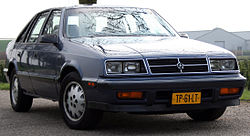
Production 1985–1989 Assembly Sterling Heights, Michigan, United States Class Mid-size Body style 5-door hatchback Layout FF layout Platform H-body Engine 2.2 l/134 cu in K I4
2.2 l/134 cu in Turbo I I4
2.2 l/134 cu in Turbo II I4
2.5 l/153 cu in K I4Transmission 5-speed manual
3-speed A413 automaticRelated Chrysler LeBaron GTS
Chrysler LeBaron
Chrysler GTS (Europe)
Shelby LancerThe Dodge Lancer was re-introduced in 1985 as a mid-sized 5-door hatchback. It was a clone to the Chrysler LeBaron GTS and was based on the Chrysler H platform, a stretched version of the Chrysler K platform. The Lancer eventually slotted between the Aries and the 600. All Lancers were built in Sterling Heights, Michigan. Production ended on April 7, 1989, replaced by the Spirit.
Lancer Shelby
The 1988 to 1989 Lancer Shelby was a factory appearance and handling package including upgraded sway bars, shorter springs, and quicker steering along with an assortment of comfort and convenience features including leather seats, power locks, windows, seats, and mirrors, a tilt steering wheel and a two-position cup holder.[citation needed]
The intercooled Turbo II engine with the manual transmission provided 175 hp (130 kW). The automatic variant was equipped with the 146 hp (109 kW) Turbo I[citation needed]. Although it was not planned as a limited edition, only 279 Lancer Shelbys were produced in 1988 and 208 in 1989[citation needed].
European market
In April 1988, Chrysler started offering some models on the European market. One of them was the Chrysler GTS, a rebadged version of the Dodge Lancer ES. Due to European vehicle regulations, the exterior appearance was slightly different. The rear turn signals were amber rather than red, the front sidemarkers and the centre hight mount stop lamp (CHMSL) were blanked off, small round repeaters were installed into the front fenders, and the sideview mirrors were of spring-hinged rather than rigid design. The engine options included the naturally aspirated 2.2 l/134 cu in Four, and a turbocharged version of the same engine. From 1989 on, the 2.5 l/153 cu in Four became available with or without a turbocharger. The 2.2 engine was dropped, except for the Turbo II version that was standard equipment on the Chrysler GTS Shelby, the European sibling of the Dodge Lancer Shelby. A five-speed manual gearbox was standard, with a three-speed automatic transmission as an extra cost option. The GTS Shelby came only with the manual transmission.
The Chrysler GTS had few buyers in Europe; the competition was too hard. Even the comparatively low prices could not help, and sales figures were very low. By the end of 1989, the GTS was replaced by the Saratoga.
References
External links
Dodge Current
productionCarsTrucks (Ram)Discontinued Cars024 · 330 · 400 · 600 · 880 · Aries · Aspen · Avenger · Brisa · Challenger · Charger (B-body) · Charger (L-body) · Charger Daytona · Colt · Conquest · Coronet · Custom 880 · Dart · Daytona · Demon · Diplomat · Dynasty · Intrepid · La Femme · Lancer · Matador · Mirada · Monaco · Neon · Omni · Phoenix · Polara · SE · Shadow · Sierra · Spirit · SRT-4 · St. Regis · Stealth · Stratus · Super BeeTrucks50 Series · 100 Series · 500 Series · A100 · B Series · C Series · D Series · Power Wagon · Rampage · Ram 50 · VC series · VF series · WC seriesCorporate Category:Dodge vehicles · Chrysler LLCDodge road car timeline, United States market, 1950s–1970s — next » Type 1950s 1960s 1970s 0 1 2 3 4 5 6 7 8 9 0 1 2 3 4 5 6 7 8 9 0 1 2 3 4 5 6 7 8 9 Subcompact Omni / 024 Colt Compact Colt Colt Colt Lancer Dart Dart Dart Aspen Mid-size Wayfarer Dart Diplomat Coronet Coronet Monaco Magnum Full-size Coronet Coronet Coronet Dart 880 / Custom 880 Royal Royal Matador 330 Monaco Monaco St. Regis Meadowbrook La Femme 440 Custom Royal Polara Polara Polara Polara Sports Charger Charger Charger Charger Challenger Challenger Super Bee « previous — Dodge road car timeline, United States market, 1980s–present Type 1980s 1990s 2000s 2010s 0 1 2 3 4 5 6 7 8 9 0 1 2 3 4 5 6 7 8 9 0 1 2 3 4 5 6 7 8 9 0 1 2 Subcompact Omni Colt Colt Colt Colt Omni 024 Charger Compact Colt 400 Shadow Neon Neon Caliber Aspen Aries Mid-size Lancer Mirada 600 Spirit Avenger Diplomat Dynasty Stratus Stratus Full-size St. Regis Monaco Intrepid Intrepid Magnum Charger Charger Sport compact Daytona Avenger SRT-4 Sports Challenger Conquest Stealth Challenger Viper Viper Viper Viper Categories:- Dodge vehicles
- Compact cars
- Front wheel drive vehicles
- Mid-size cars
- Rear wheel drive vehicles
- Coupes
- Hatchbacks
- Sedans
- Station wagons
- 1950s automobiles
- 1960s automobiles
- 1980s automobiles
- Vehicles introduced in 1955
Wikimedia Foundation. 2010.


